
Peroz I was the Sasanian King of Kings of Iran from 459 to 484. A son of Yazdegerd II, he disputed the rule of his elder brother and incumbent king Hormizd III, eventually seizing the throne after a two-year struggle. His reign was marked by war and famine. Early in his reign, he successfully quelled a rebellion in Caucasian Albania in the west, and put an end to the Kidarites in the east, briefly expanding Sasanian rule into Tokharistan, where he issued gold coins with his likeness at Balkh. Simultaneously, Iran was suffering from a seven-year famine. He soon clashed with the former subjects of the Kidarites, the Hephthalites, who possibly had previously helped him to gain his throne. He was defeated and captured twice by the Hephthalites and lost his recently acquired possessions.

Bahram II was the fifth Sasanian King of Kings (shahanshah) of Iran, from 274 to 293. He was the son and successor of Bahram I. Bahram II, while still in his teens, ascended the throne with the aid of the powerful Zoroastrian priest Kartir, just like his father had done.

Kanishka II was one of the emperors of the Kushan Empire from around 225–245 CE. He succeeded Vasudeva I who is considered to be the last great Kushan emperor.

Vāsudeva I was a Kushan emperor, last of the "Great Kushans." Named inscriptions dating from year 64 to 98 of Kanishka's era suggest his reign extended from at least 191 to 232 CE. He ruled in Northern India and Central Asia, where he minted coins in the city of Balkh (Bactria). He probably had to deal with the rise of the Sasanians and the first incursions of the Kushano-Sasanians in the northwest of his territory.
The Kidarites, or Kidara Huns, were a dynasty that ruled Bactria and adjoining parts of Central Asia and South Asia in the 4th and 5th centuries. The Kidarites belonged to a complex of peoples known collectively in India as the Huna, and in Europe as the Chionites, and may even be considered as identical to the Chionites. The 5th century Byzantine historian Priscus called them Kidarite Huns, or "Huns who are Kidarites". The Huna/Xionite tribes are often linked, albeit controversially, to the Huns who invaded Eastern Europe during a similar period. They are entirely different from the Hephthalites, who replaced them about a century later.
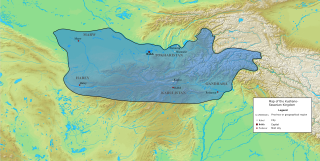
Kushano-Sasanian Kingdom was a polity established by Sasanian Persians in Bactria during the 3rd and 4th centuries CE. The Sasanian Empire captured the provinces of Sogdiana, Bactria and Gandhara from the declining Kushan Empire following a series of warsin 225 CE. The local Sasanian governors then went on to take the title of Kushanshah or "King of the Kushans", and to mint their own coins. They are sometimes considered as forming a "sub-kingdom" inside the Sasanian Empire. This administration continued until 360-370 CE, when the Kushano-Sasanians lost much of their domains to the invading Kidarite Huns, whilst the rest was incorporated into the imperial Sasanian Empire. Later, the Kidarites were in turn displaced by the Hephthalites. The Sasanians were able to re-establish some authority after they destroyed the Hephthalites with the help of the Turks in 565, but their rule collapsed under Arab attacks in the mid 7th century.

Kipunada, also Kipanadha, was probably the last ruler of the Kushan Empire around 335-350 CE. He is known for his gold coinage. He succeeded Shaka I. Kipunada was probably only a local ruler in the area of Taxila, in western Punjab, and he may have been a subject of Gupta Emperor Samudragupta.
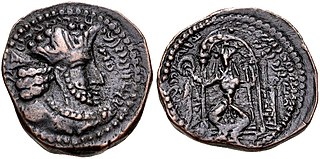
Kushanshah was the title of the rulers of the Kushano-Sasanian Kingdom, the parts of the former Kushan Empire in the areas of Sogdiana, Bactria and Gandhara, named Kushanshahr and held by the Sasanian Empire, during the 3rd and 4th centuries CE. They are collectively known as Kushano-Sasanians, or Indo-Sasanians.
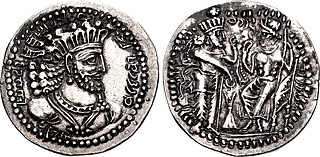
Peroz I Kushanshah was Kushanshah of the Kushano-Sasanian Kingdom from 245 to 275. He was the successor of Ardashir I Kushanshah. He was an energetic ruler, who minted coins in Balkh, Herat, and Gandhara. Under him, the Kushano-Sasanians further expanded their domains into the west, pushing the weakened Kushan Empire to Mathura in North India.

Hormizd I Kushanshah was Kushanshah of the Kushano-Sasanian Kingdom from 275 to 300. His reign was marked by his rebellion against his brother and suzerain the Sasanian King of Kings Bahram II.

Ardashir I Kushanshah was the first Kushanshah of the Kushano-Sasanian Kingdom from 233 to 245. He was succeeded by Peroz I Kushanshah.
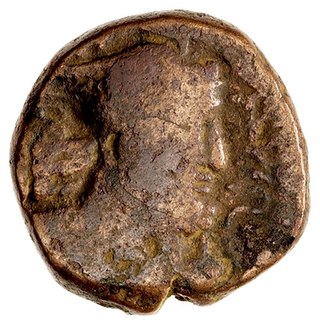
Hormizd II Kushanshah, was Kushanshah of the Kushano-Sasanian Kingdom from 300 to 303. Like his predecessors, he was, in effect a governor of the Sasanian Empire for the eastern regions of Marw, Tukharistan and Gandhara which had been captured following the defeat of the Kushan Empire in 230. Since the reign of his predecessor Hormizd I Kushanshah, copper drachms were minted with the names of two local governors, Meze and Kavad.
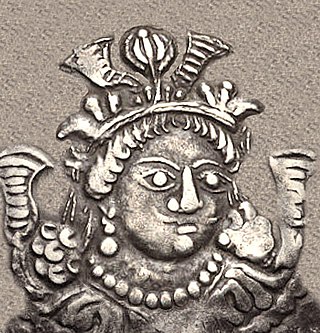
Kidara I fl. 350-390 CE) was the first major ruler of the Kidarite Kingdom, which replaced the Indo-Sasanians in northwestern India, in the areas of Kushanshahr, Gandhara, Kashmir and Punjab.

The term Iranian Huns is sometimes used for a group of different tribes that lived in Central Asia, in the historical regions of Transoxiana, Bactria, Tokharistan, Kabul Valley, and Gandhara, overlapping with the modern-day Afghanistan, Tajikistan, Uzebekistan, Eastern Iran, Pakistan, and Northwest India, between the fourth and seventh centuries. They also threatened the Northeast borders of Sasanian Iran and forced the Shahs to lead many ill-documented campaigns against them.

Peroz II Kushanshah was the penultimate Kushanshah of the Kushano-Sasanian Kingdom from 303 to 330. He was the successor of Hormizd II Kushanshah.

Peroz, was according to modern scholarship an early Kidarite ruler in Gandhara, right after the end of Kushano-Sasanians.

Kirada, is considered by modern scholarship as the first known ruler of the Kidarite Huns in the area of Gandhara in northwestern India, possibly at the same time as another Kidarite ruler named Yosada.

Mahi was a Kushan ruler, whose reign is dated to circa 300–305 CE. He probably succeeded Vasudeva II, and his successor was Shaka. Mahi was among the last Kushan Emperors, before they were overrun by the Kidarites.
Hind was the name of a southeastern Sasanian province lying near the Indus River. The boundaries of the province are obscure. The Austrian historian and numismatist Nikolaus Schindel has suggested that the province may have corresponded to the Sindh region, where the Sasanians notably minted unique gold coins of themselves. According to the modern historian C. J. Brunner, the province possibly included—whenever jurisdiction was established—the areas of the Indus River, including the southern part of Punjab.

Tobazini, Gobazini or Goboziko was a ruler of southern Central Asia. He is only known from his coinage, found in Bactria and Northern Afghanistan. The legends on his coins are in Bactrian, but they are often difficult to read: a typical legend reads t/gobazini/o šauo "King Tobazini". Tobazini is often considered one of the last rulers of the Kidarites, circa 450 CE.




















